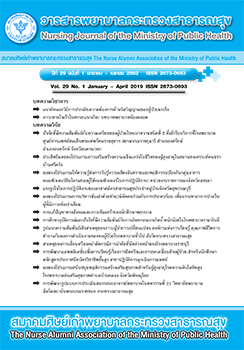Social Problem-solving and Depression among Nursing Students
Main Article Content
Abstract
Nursing students are at risk of depression since they have to adapt themselves to changes in their personal developmental, learning and teaching styles, and the university environment. This research aimed to explore depression and the relationship of social problem-solving and depression among 650 nursing students studying at the Nursing Faculty of one particular university in the Eastern part of Thailand in academic year 2017. Three research instruments were used to collect the data, including an Information form, the Center for Epidemiologic Studies Depression Scale, and the Social Problem-solving Inventory for Adolescents, each giving a Cronbach’s alpha of .89, and .83, respectively. Descriptive statistics, one-way ANOVA and Pearson’ product moment coefficient analysis were employed for data analyses. The results revealed that 32% of nursing students had depression in which 18 percent had mild and moderate depression and 14 percent had severe depression. There were significant differences in the occurrence of depression which varied according to the year of study, with significance level of .05 (F3,436=3.484, p<.05). Moreover, nursing students had a moderate level of social problem-solving ( =107.28, SD=13.05). The correlation analysis showed that depression had a negative relationship with social problem-solving among nursing students (r=-.497, p<.001).
The research findings indicate that depression among the nursing students is a major mental health issue that needs to be addressed by faculty members or related health care providers through the development of the mental health services focused on enhancing the social problem-solving skills of nursing students.
Article Details
บทความและรายงานวิจัยในวารสารพยาบาลกระทรวงสาธารณสุข เป็นความคิดเห็นของ ผู้เขียน มิใช่ของคณะผู้จัดทำ และมิใช่ความรับผิดชอบของสมาคมศิษย์เก่าพยาบาลกระทรวงสาธารณสุข ซึ่งสามารถนำไปอ้างอิงได้
References
2. Ministry of Education, Thailand. Thailand Qualification Framework (TQF) for Undergraduate Nursing. Bangkok: Ministry of Education; 2017. (in Thai).
3. Tantalanukul S. Wongsawat P. Stress and stress management in nursing students. Boromarajonani College of Nursing, Uttaradit Journal 2017; 9(1):81-92.(in Thai).
4. Seyedfatemi N. Tafreshi M. Hagani H. Experienced stressors and coping strategies among Iranian nursing students. BMC Nursing 2007; 6(11):1-10.
5. Dallas JC. Puapan S. Vatanasin D. Factors influencing mental health status among nursing students. Journal of Faculty of Nursing Burapha University 2015; 23(3): 1-13. (in Thai).
6. Deepaisarnsakul P. Expectation and perception of the clients about the service quality of the hospital. Veridian E-Journal SU 2013; 6(1):573-92. (in Thai).
7. TantalanukulS. Wongsawat P. Stress and Stress Management in Nursing Students. Boromarajonani College of Nursing, Uttaradit Journal 2017; 9(1):81-92. (in Thai).
8. Limthongkul M. Aree-Ue S. Sources of stress, coping strategies, and outcomes among nursing students during their initial practice. Ramathibodi Nursing Journal 2011;15(2): 478-92. (in Thai).
9. Vinijkul S. Reansuwong S. Sukarate P. Relationship between academic environment, learning happiness, and academic achievement of nursing Students at Kuakarun Faculty of Nursing, Navamindradhiraj University. Kuakarun Journal of Nursing 2014;21:7-24. (in Thai).
10. Kaewmart N. Koedbangkham J. Nabkasorn C. Factors influencing depression among nursing students of Burapha University. Journal of Faculty of Nursing Burapha University 2011; 19(2):84-95. (in Thai).
11. Kaewprom K. Chernarome C. Interpersonal interaction and depression in undergraduate nursing students. Journal of Nurses’ Association of Thailand, North-Eastern Division 2013;31(4):128-35. (in Thai).
12. Beck AT. Alford BA. Depression: Clinical, experimental, and theoretical aspects (2nded.). Pennsylvania: University of Pennsylvania Press2009.
13. Gladstone TR. Beardslee WR. The prevention of depression in children and adolescents: a review. The Canadian Journal of Psychiatry 2009; 54(4):212-21.
14. D’Zurilla TJ.Nezu AM.Maydeu-Olivares A. Social Problem Solving: Theory and Assessment. In ECChang, TJD’Zurilla LJSanna(Eds.), Social problem solving: Theory, research, and training (pp. 11-27). Washington, DC, US: American Psychological Association 2004.
15. Vatanasin D. Hengudomsub P. Vatanasin S. Asarath T. Chupan S. Srisopa P. Factors Predicting Depression among Health Science Students. Journal of Faculty of Nursing Burapha University 2015;23(4):46-62. (in Thai).
16. Frauenkenecht M. Black DR. Social Problem Solving Inventory for Adolescents (SPSI-A): A manual for application, interpretation, and psychometric evaluation. Morgantown: PNG publication 2003.
17. Radloff LS. The CES-D scale: A self-report depression scale for research in the general population. Applied Psychological Measurement 1977;1:385-401.
18. Trangkasombat U. Larpboonsarp V. Havanond P. CES-D as a screen for depression in adolescents. Journal of the Medical Association of Thailand 1997;42(1):2-13. (in Thai).
19. Inchuanee P. Kaiwikaikosol A. Buapan K. Mental health of first year nursing Students, Boromarajonani college of Nursing, Buddhachinaraj. Pitsanulok: BoromarajonaniCollege of Nursing Buddhachinaraj 2008. (in Thai).
20. Samarksavee N. Sangon S. Factors associated with depression in nursing students. The Journal of Psychiatric Nursing and Mental Health 2015; 29(3): 11-27. (in Thai).
21. Reinecke MA. DuBois DL. Schultz TM. Social problem solving, mood, and suicidality among inpatient adolescents. Cognitive Therapy and Research 2001;25:743-56.
22. Anderson RJ. Goddard L. Powell JH. Social problem solving and depressive symptom vulnerability: the importance of real-life problem-solving performance. Cognitive Therapy and Research 2011; 35: 48-56.
